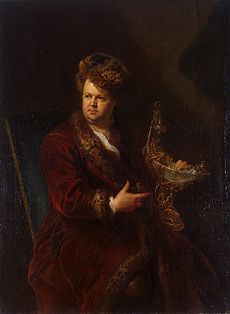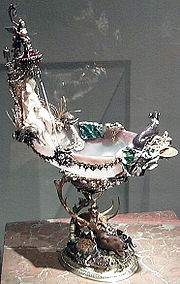
Johann Melchior Dinglinger
Encyclopedia

Goldsmith
A goldsmith is a metalworker who specializes in working with gold and other precious metals. Since ancient times the techniques of a goldsmith have evolved very little in order to produce items of jewelry of quality standards. In modern times actual goldsmiths are rare...
s, whose major works for the elector of Saxony, Augustus the Strong, survived in the Grünes Gewölbe
Grünes Gewölbe
The Grünes Gewölbe in Dresden is a unique historic museum that contains the largest collection of treasures in Europe. Founded by Augustus the Strong in 1723, it features a rich variety of exhibits from the Baroque to Classicism...
(the "Green Vaults"), Dresden
Dresden
Dresden is the capital city of the Free State of Saxony in Germany. It is situated in a valley on the River Elbe, near the Czech border. The Dresden conurbation is part of the Saxon Triangle metropolitan area....
.
Dinglinger was the last goldsmith to work on the grand scale of Benvenuto Cellini
Benvenuto Cellini
Benvenuto Cellini was an Italian goldsmith, sculptor, painter, soldier and musician, who also wrote a famous autobiography. He was one of the most important artists of Mannerism.-Youth:...
and Wenzel Jamnitzer
Wenzel Jamnitzer
Wenzel Jamnitzer was a Northern Mannerist goldsmith, artist, and printmaker in etching, who worked in Nuremberg...
, fewer of whose large-scale works in precious materials have survived, however.. His work carries on in a Mannerist
Mannerism
Mannerism is a period of European art that emerged from the later years of the Italian High Renaissance around 1520. It lasted until about 1580 in Italy, when a more Baroque style began to replace it, but Northern Mannerism continued into the early 17th century throughout much of Europe...
tradition into the "Age of Rococo
Rococo
Rococo , also referred to as "Late Baroque", is an 18th-century style which developed as Baroque artists gave up their symmetry and became increasingly ornate, florid, and playful...
".
Biography
Dinglinger was born in Biberach an der RißBiberach an der Riß
Biberach is a town in the south of Germany. It is the capital of Biberach district, in the Upper Swabia region of the German state of Baden-Württemberg...
(today in Baden-Württemberg
Baden-Württemberg
Baden-Württemberg is one of the 16 states of Germany. Baden-Württemberg is in the southwestern part of the country to the east of the Upper Rhine, and is the third largest in both area and population of Germany's sixteen states, with an area of and 10.7 million inhabitants...
). He served his apprenticeship in Ulm
Ulm
Ulm is a city in the federal German state of Baden-Württemberg, situated on the River Danube. The city, whose population is estimated at 120,000 , forms an urban district of its own and is the administrative seat of the Alb-Donau district. Ulm, founded around 850, is rich in history and...
, after which he refined his techniques working as a journeyman
Journeyman
A journeyman is someone who completed an apprenticeship and was fully educated in a trade or craft, but not yet a master. To become a master, a journeyman had to submit a master work piece to a guild for evaluation and be admitted to the guild as a master....
in Augsburg
Augsburg
Augsburg is a city in the south-west of Bavaria, Germany. It is a university town and home of the Regierungsbezirk Schwaben and the Bezirk Schwaben. Augsburg is an urban district and home to the institutions of the Landkreis Augsburg. It is, as of 2008, the third-largest city in Bavaria with a...
, Nuremberg
Nuremberg
Nuremberg[p] is a city in the German state of Bavaria, in the administrative region of Middle Franconia. Situated on the Pegnitz river and the Rhine–Main–Danube Canal, it is located about north of Munich and is Franconia's largest city. The population is 505,664...
and Vienna
Vienna
Vienna is the capital and largest city of the Republic of Austria and one of the nine states of Austria. Vienna is Austria's primary city, with a population of about 1.723 million , and is by far the largest city in Austria, as well as its cultural, economic, and political centre...
, three traditional centers of luxury arts. He went to Dresden in 1692, where he spent the rest of his career in the service of Augustus, by whom he was appointed court jeweller in 1698. In the workshop he established, he was assisted by his younger brothers, the enameller Georg Friedrich Dinglinger (1666–1720) and Georg Christoph Dinglinger (1668–1728), who specialized in cutting and setting jewels. The sculptor Balthasar Permoser
Balthasar Permoser
Balthasar Permoser was among the leading sculptors of his generation, whose evolving working styles spanned the late Baroque and early Rococo....
collaborated as a modeller in Dinglinger's workshops.
Dinglinger married five times and had twenty-three children, of whom eleven survived to maturity. The famous house he erected in Dresden was burned in the Seven Years' War
Seven Years' War
The Seven Years' War was a global military war between 1756 and 1763, involving most of the great powers of the time and affecting Europe, North America, Central America, the West African coast, India, and the Philippines...
. He died in Dresden
Dresden
Dresden is the capital city of the Free State of Saxony in Germany. It is situated in a valley on the River Elbe, near the Czech border. The Dresden conurbation is part of the Saxon Triangle metropolitan area....
.
Works

- 1697–1701 The Golden Coffee Service, which presents the cups and saucers and sugar bowls on an elaborate pyramidal etagère surmounted by the coffeepot, all in enamelled gold, a kabinettstuck unique in Europe. Augustus took the recently-completed ensemble with him to WarsawWarsawWarsaw is the capital and largest city of Poland. It is located on the Vistula River, roughly from the Baltic Sea and from the Carpathian Mountains. Its population in 2010 was estimated at 1,716,855 residents with a greater metropolitan area of 2,631,902 residents, making Warsaw the 10th most...
at Christmas 1701, to dazzle the nobles of the Polish-Lithuanian CommonwealthPolish-Lithuanian CommonwealthThe Polish–Lithuanian Commonwealth was a dualistic state of Poland and Lithuania ruled by a common monarch. It was the largest and one of the most populous countries of 16th- and 17th‑century Europe with some and a multi-ethnic population of 11 million at its peak in the early 17th century...
of which he was the nominal ruler. - The Birthday of the Grand Mogul AurangzebAurangzebAbul Muzaffar Muhy-ud-Din Muhammad Aurangzeb Alamgir , more commonly known as Aurangzeb or by his chosen imperial title Alamgir , was the sixth Mughal Emperor of India, whose reign lasted from 1658 until his death in 1707.Badshah Aurangzeb, having ruled most of the Indian subcontinent for nearly...
, with 137 modelled enamelled and jewel-encrusted figures of men and animals, which Dinglinger commenced without a specific commission, and sold to the delighted Elector for a spectacular 55,485 thaler . The invasion of Saxony by Charles XII of SwedenCharles XII of SwedenCharles XII also Carl of Sweden, , Latinized to Carolus Rex, Turkish: Demirbaş Şarl, also known as Charles the Habitué was the King of the Swedish Empire from 1697 to 1718...
made payments difficult and the greater part of the vast sum was owing until 1713. - 1704 Dianabad (The "Bath of Diana"), in which a chalcedonyChalcedonyChalcedony is a cryptocrystalline form of silica, composed of very fine intergrowths of the minerals quartz and moganite. These are both silica minerals, but they differ in that quartz has a trigonal crystal structure, while moganite is monoclinic...
bowl in a filigree is supported between the horns of a stag's head. - 1722 Obeliscus Augustalis
- Altar of Apis, an unusual example, for its generation, of Egyptianizing taste
- before 1722 Pair of agate standing cups celebrating the election of Augustus as King of Poland, mounted in gold, enamel, parcel gilt silver, and semi-precious stones

